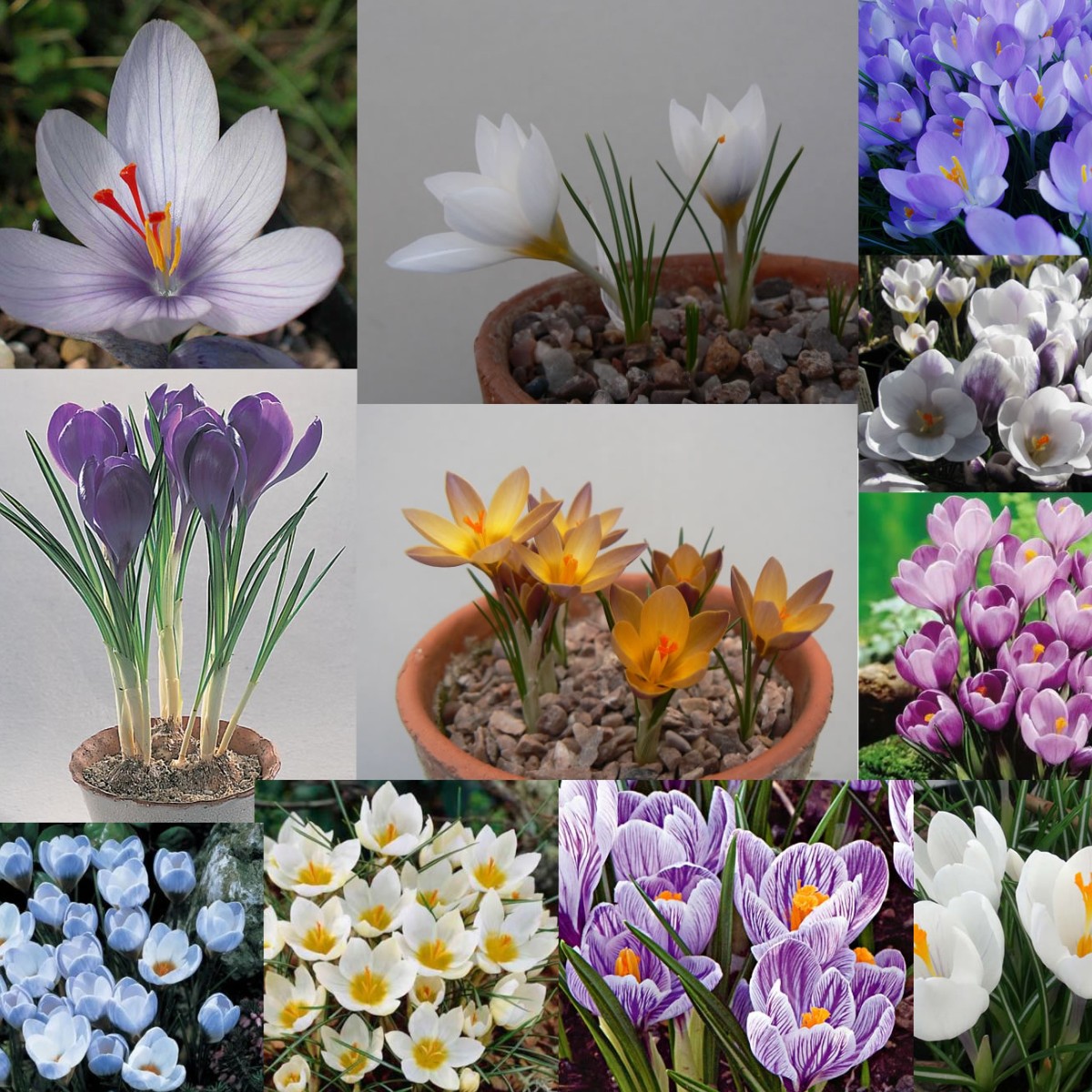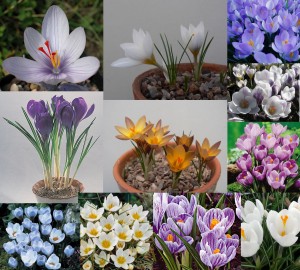Common name: Crocus
Family: Iridaceae
Distibution and habitat: Crocus species are native to woodland, scrub and meadows from sea level to alpine tundra in central and southern Europe, North Africa and the Middle East, on the islands of the Aegean, and across Central Asia to western China.
Description: Crocus species are winter flowering plants which are grown from small corms. Their slender, grooved leaves are dark green striped with white and their cup-shaped flowers may be purple, mauve, white, bronze, yellow or striped with two colours. The maximum height of these plants is about 10-12cm (4-5 inch). Outdoors they produce roots and little or no growth during the cold winter months and have a brief flowering period at the beginning of the spring. After this, most of leaves grow and die down within a couple of months.
Individual flowers will last from two to five days, but plants can last from seven to 12 days. The lasting quality will vary greatly by cultivar as well as the temperature and light levels in which the plants are displayed.
Houseplant care: Dutch hybrids which have flowers two or three times the size of the true species, make the most satisfactory house plants. Use only one flower colour for each container, since different coloured hybrids may bloom at different times.
Planting: Crocuses to be displayed indoors should be encouraged to make root growth before top growth gets well under way and they will do this only if kept cool. Plant several corms together just bellow the surface of a soil based potting mixture. Containers may be shallow pots, half-pots or bowls. Crocuses planted in bowls without drainage holes need to be watered with great care.
Plant-up bowls or pots outdoor and bury them beneath a thick covering of peat moss. Ideally they should not be brought inside until the flower buds begin to show some colour. Indoor plants then can be enjoyed while they are in bloom.
Alternatively, plant them early in the autumn, water only enough to keep the potting mixture just moist and place the plants in as cool and dark position as possible if the outdoor burial is not feasible. An ideal procedure for apartment dweller is to cover the prepared pots or bowls with a black plastic bag and put them out on a basement, unheated garage balcony or refrigerator in cool temperature (about 4C - 40F). Inspect them from time to time to make sure that no further watering is required. It will not be necessary unless the potting mixture dries out completely. Crocuses need a cold treatment for 12 weeks to bloom. In mid-winter the potted plants may be brought into gentle warmth (maximum 15C - 59F). For their short stay in home, keep them cool, out of direct sunshine, but in bright light.
Water them moderately.
When flowering has ended, they can be put outside again and can either be left to wither naturally in the pots - after which the corms should be dried for autumn replanting in the open ground or else they can be planted in ground directly. They will not flower again indoors.
Light: Bright, diffused light is best for indoors. Full sun or filtered sunlight is best if Crocuses are displayed outside.
Temperature: Cool areas 13 to 18C (55-65F) are best for displaying Crocuses.
Keep humidity at moderate levels for Crocuses.
Water: Keep the potting mixture evenly moist. Severe drying will cause leaf yellowing and drop and also will delay flower development.
Feeding: Apply a bloom fertilizer in moderation at every watering. An African violet food is a good choice.
Propagation: Crocus are grown from corms, a bulb-like stem. It will produce offsets, but they take a few years to mature. The mother corm will produce several baby corms, then usually die in the same year. The new corms can be dug up and separated to be replanted. Make sure to mark and keep colors separate.
Crocus tolerates overcrowding, but dividing in autumn the corms is a good way to introduce the flower to other areas of the garden or for indoor display.
Plant the new Crocus corms as soon as possible after collecting them. For storage, place them in a 4 to 10C (40-50F) darkened area before planting.
Also Crocus can be propagated by seed sown in autumn. It can take up to three years before seed sown plants produce flowers.
Problems:
Crocus blooms attract thrips and aphids.
Treatment: Control them with a solution of insecticidal soap.
Recommended varieties:
Crocus 'Pickwick' has silvery lavender petals with dark purple stripes.
Crocus 'Remembrance' giant blooms are shiny, deep purple.
Crocus 'Flower Record' giant Crocus is available in several colors.
Availability: Seed, cornsare available at nurseries and garden centres. Corns are preferable as seed takes years to flower. Also pots with flowers are available form late winter though spring.
Toxicity: The corms of the Crocus species can be toxic to some people and other animals if eaten, but these flowering plants are listed as an allergy-safe pollen-producing plant.
Uses: Crocus hybrids are the perfect choice for spring displays. They stand well alone or grouped with other spring-flowering and foliage plants. They also make an ideal choice for rock gardens.
SUMMARY:
CHARACTERISTICS:
Foliage green
Features flowers
Shape upright
Height: 10-12cm (4-5 inch)
PROPER CARE:
Watering in active growth period sparingly
Light bright filtered
Temperature in active growth period min 7C max 16C (45-61F)
Humidity high
Hardiness zone: 3a-8b
Begonia propagation f...
Essential Nutrients f...
Portulacaria afra
Tillandsia recurvata
Tillandsia stricta
Columnea microphylla
Clivia miniata
Cleyera japonica
Clerodendrum thomsoni...
Cleistocactus strausi...



